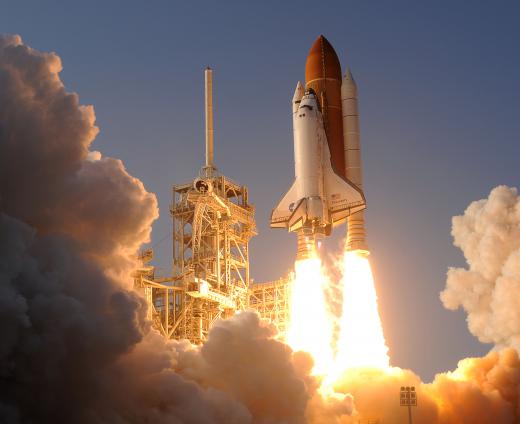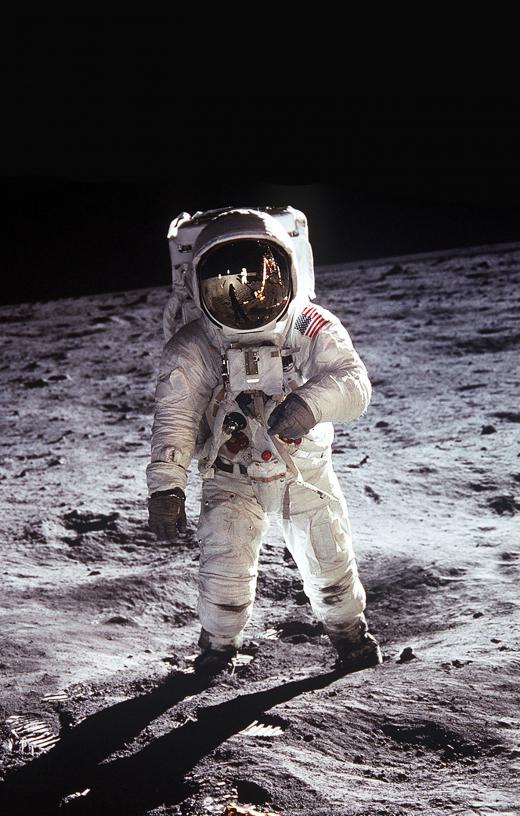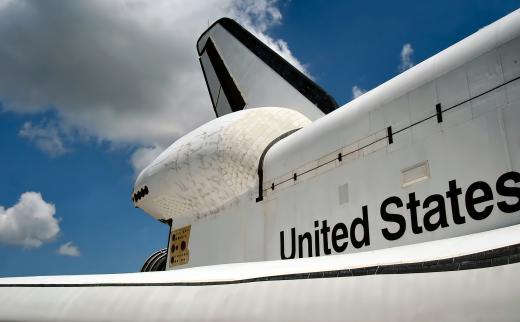What is NASA?
 Mary McMahon
Mary McMahon
The National Aeronautics and Space Administration (NASA) is an American government agency that runs the civilian arm of the space program. The aim of this agency is to increase human understanding of the solar system and the universe that contains it, and to improve American aeronautics ability. Under its charter, NASA is supposed to be a peacetime agency that does not perform military functions, although it does cooperate with the military, and many employees have a military background. To achieve this goal, the agency has an annual budget that can be counted in the billions to fund programs and pay tens of thousands of employees.
NASA was founded in 1958, in response to the Soviet launch of Sputnik in 1957. The early years of the organization were driven by Cold War competitiveness, and it quickly worked on creating rockets that would allow for manned spaceflight. Astronauts Neil Armstrong and Buzz Aldrin were the first humans to have set foot on the moon in 1969, an action that was considered a major victory for American aeronautics. Riding on this early success, NASA continued development of aeronautic equipment designed to function outside the Earth's atmosphere.

After the moon landing, NASA focused on doing research around the solar system, sending an assortment of manned flights to the moon to collect material for study, and unmanned drones to other planets to collect data. These flights have collected large amounts of data which are constantly being added to and analyzed. Scientific advancement is a large part of its mission. With the assistance of the agency, scientists have been able to conduct experiments in the zero gravity environment of space, and test hypotheses about the universe.

NASA also continues to work on a program to make space more accessible. When the space shuttle program ended in 2011, 135 flights had been made with astronauts from many nations, including the United States. Two of these flights, the Challenger and Columbia, were lost. The agency plans to resume manned flights in the future, after the development of a new space transportation vehicle.

As part of its mission as a peaceful agency, NASA cooperates with agencies within the United States and international aeronautics agencies. A US astronaut can usually be found on board the International Space Station, and astronauts from other nations are invited to participate in NASA events. This fostering of international cooperation will hopefully continue as humans explore space and the possibility of off-Earth human settlements becomes possible.
AS FEATURED ON:
AS FEATURED ON:





















Discussion Comments
@irontoenail - Personally, I think it has more to do with the mind set of people at the moment, and, more importantly, their mindset a couple of decades ago when the funding started being withdrawn. Money was becoming tighter, and people weren't taking for granted that the United States had endless coffers the way they did in the 50's and 60's when they were going through an economic boom.
And now, when money seems to be tighter than ever, and the world feels like a frightening place, it seems more and more frivolous to spend it on space travel, rather than on defense or housing or whatever.
The only way that we are ever going to get a real push into space is, god forbid, through another space race due to war, or one due to economics. If they discover metals or an energy source on Mars, you can bet we'll have people there within a decade.
@bythewell - Unfortunately, I think when people think about NASA it's the Challenger that comes to mind and that was such a sad and public failing that it's a strong association. And it has led to less funding.
It's easy to forget that there was over 130 successful missions, or that they were basically riding explosions into space. We all knew that at some point something would go wrong. The fact that it happened so rarely says something.
@PelesTears - That's interesting. I did know that NASA has developed a lot of the technology we use in everyday life, like freeze dried food, or the plastic they use in the soles of shoes. But I didn't know they were actively involved in developing flight technology for flights in the atmosphere.
The huge amount of knowledge and enthusiasm and cooperation shown by NASA is one of the reasons I wish they were getting more funding. I know people complain about how it's a "waste" but honestly, they get such a tiny amount compared with, say, the defense budget and they do so much with it, I think it's a waste they don't get more opportunities.
@ PelesTears - It’s interesting that you bring up the point about NASA being involved in developing technologies for commercial air travel, because I read an article recently about an initiative for a 'green' plane. The GE open rotor engine testing is associated with the NASA initiative to create a cleaner, quieter, and more efficient twin aisle commercial aircraft by 2025. NASA is offering research contracts and cash prizes for a few proposals that can lead to a 50% reduction of fuel consumption and emissions, and an even larger reduction in noise. The prizes and contracts could be worth tens of millions of dollars, and potential development of prototypes. I know that MIT has already submitted a proposal for a green commercial airliner, but I am not sure of any other teams. The deadline is in the middle of the summer, and the program was announced last year, so I am sure that there will be some worthy proposals. Imagine the reduction in emissions if the millions of flights a year only used half the fuel to get to their destinations.
I would like to point out that aeronautics applies to the study of flight both within our atmosphere and in space. The reach of NASA's research is broader than what is described in the article. NASA researches, designs, and develops technologies that are used by the military as well as technologies to be used by the public sector. They often team up with companies in the private sector, developing new and safer technologies for air travel. NASA's work includes projects like the predator drones, and its sister crafts (developed for the different branches of the military), satellite technologies, rocket technologies, instruments used in astronomy, materials technologies, and propulsion systems (There are probably many more that I either do not know about or are classified). For example, NASA is currently collaborating with GE on an open rotor jet engine that is being tested at the Glenn research facility in Cleveland. The design will allow for the reduced fuel consumption that is synonymous with propeller engines coupled with the speed and noise attributes of a jet engine.
Post your comments